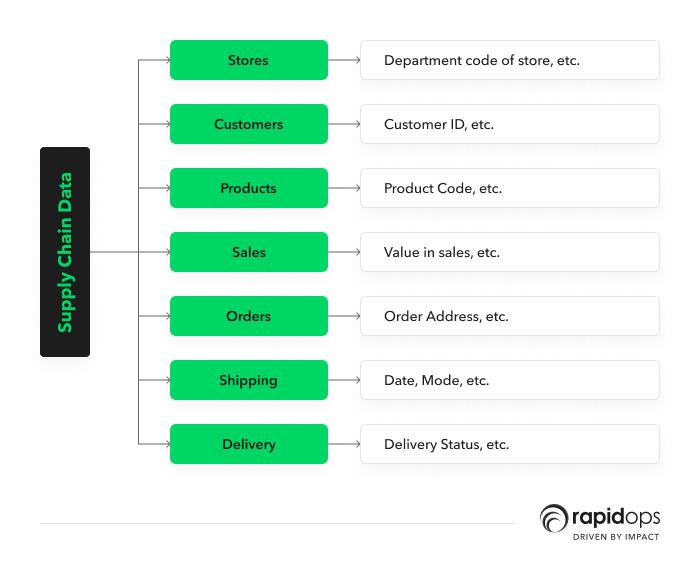Since your supply chain generates data in a bulk quantity, big data in this digital era is critical in disrupting your supply chain management. Supply chains generate data in large volumes, and big supply-chain analytics helps in turning that raw data into useful insights. In this article, we will take a digital supply chain consulting approach to help you understand the benefits of a digitized supply chain.
The marketplace is growing even more competitive, with
- The rise in economic globalization
- Rising customer expectations
- Information and technology development
Modern supply chain professionals are struggling to handle the huge data influx to derive an integrated, efficient, and agile supply chain. Explosive growth in data volume and managing different data types throughout the supply chain requires technology to rapidly analyze all that data. BDA (big data analytics) capability enables supply chain professionals to use big data tools for extracting valuable information from that large, big-data pool.
What is the role of big data analytics in the supply chain?
Big data analytics is playing a very crucial role in improving supply chain management. There are different pain points in strategic and operational levels that can be resolved with the proper application of big data analytics. Supply chain management (SCM) helps create a seamless flow of goods, services, and information between interconnected entities and activities.
Supply chain management (SCM) aims at
- Cost savings
- Enhancing productivity
- Delivering products and services quickly and safely
With multiple manufacturers, vendors, distributors, and channels, the complexity in the supply chain only increases. The complexity arises as all these complex supply chain channels produce their own data. Collecting and analyzing this huge data volume for any enterprise is a challenging feat to achieve.
Big data analytics plays the role of collecting and utilizing big data across all the departments and tools used within an enterprise. Big data is engineered in such a way that it can handle a crazy amount of data influx, so more the data, more accurate results.
What are the areas in supply chain management that benefit the most from big data?
So, this brings us to the most important section of this article. How and where does big data benefit the supply chain? Let’s see an in-depth review of the same here.
Predicting the inventory requirement

Every business must capitalize on unrealized productivity opportunities as soon as they present themselves. Businesses can successfully predict sales trends and inventory fluctuations by analyzing rich data and using intelligent predictive analytics.
No advanced algorithm was capable of predicting the impact of the COVID-19 pandemic. However, big data systems are capable of keeping companies informed about their supply and demand cycle.
As fitness centers were closed down across the nation and people opted for working out at home more, the sales of Peloton, an indoor bike, skyrocketed. Peloton did experience a supply shortage due to a sudden spike in demand for their product as customers had to wait several months for receiving their shipments.
“The Unexpected rise in demand for our products has led to increases in delivery times. Our goal is to continue to scale production and be able to deliver bikes to as many people as possible.” Peloton gave this statement to a Toronto TV network.
Big data analytics was capable enough of avoiding the fiasco. Big data relates past sales trends with predictive technology and provides the expected demands to inventory managers. This significantly cuts costs and allows them to have enough supplies without over-ordering.
Safekeeping product quality and managing temperature control

Industries like food, agriculture, pharmaceuticals, and chemical processing chains require strict monitoring and controlling of specific elements in the supply chain. A slight change in temperature can hamper the product quality.
Lack of technological support for maintaining control causes about 30% of temperature-controlled products to get damaged before they reach their destination. Temperature monitoring and logistical support are key elements for healthcare as vaccine vials are only useable for a specific time at a certain temperature.
Cold chain monitoring technology supports temperature-sensitive product logistics via data logging. Logistics and supply chain managers can monitor temperature fluctuations in real-time during packaging, shipping, and delivery.
Using big data systems also helps prevent potential disruptions based on weather changes or traffic delays. It creates a comprehensive control system for effective supply management from start to finish while reducing the wastage of valuable products.
Real-time order tracking and fulfillment
![]()
For better-enhanced productivity and customer satisfaction, it is crucial to have efficient order fulfillment and traceability. Amazon changed the game by offering shorter delivery times along with estimated drop-off times. Big data enables businesses from all industries to offer omnichannel experiences to their customers. With up-to-date shipping information, delivery fleet management can experience cut costs by optimizing route, delivery schedules, and product location.
The best example of optimal supply chain data analysis can be credited to UPS. It utilizes supply chain data analysis through every step of its shipping process. As the packages move through their supply chain, radars and sensors capture that data. Big data systems then optimize the deliverer’s routes, ensuring timely delivery of packages. Through this process, UPS saves 1.6 million gallons of gasoline in their trucks every year. Additionally, in the case of a delivery exception ups is able to use this process to provide their customers with real time updates about the status of their packages.
Big data in supply chain
When we talk about data in the context of supply chains, it can be segregated can be categorized into
- Customer
- Shipping
- Delivery
- Order
- Sale
- Store
- Product

The above image showcases the anatomy of the general supply chain for any company. We can see that the supply chain data originates from segmented sources such as
- Sales
- Inventory
- Manufacturing
- Warehousing
- Transportation
From the above segments, we can further segregate the supply chain data into
- Competition
- Price volatilities
- Technological development
- Varying customer commitments
These factors lead to underestimating or overestimating product demand in already established supply and demand forecasts.
For increasing demand forecast precision, careful analysis of supply chain data is necessary. It enhances the company’s knowledge of
- market trends
- customer behavior
- suppliers
- technologies
When businesses can successfully extract trends and patterns from all the collected data, they can improve the accuracy of future predictions. This directly minimizes overall supply chain costs.
Businesses that have ideally used analytics in the supply chain
Let’s now dive into the companies that have successfully implemented supply chain analytics.
1. Amazon
The e-commerce giant uses big data to meet its customer demands more efficiently. It analyzes customers’ recent purchases, products in their shopping cart, products they have searched or kept on the wishlist. Big data analytics enables Amazon to present customers with suggestions similar to their needs and requirements. Amazon’s personalized recommendation system accounts for 35% of the company’s annual sales. Amazon has worked with the motive of delivering orders faster than its rivals. This was further boosted by the launch of One-Day Delivery in 2019. Amazon connects directly with manufacturers and tracks their inventory. It then opts for the warehouse nearest to the vendor and the customer. This move helps them decrease costs by 10-40%.
2. Starbucks
Starbucks makes 90mn transactions weekly across its 25,000 stores. Their rewards app provided helpful insight into its customers’ spending habits. With over 17mn active mobile app users, Starbucks’ rewards app has around 13mn active users. Starbucks gets information about its customers’ favorite drinks and entices them to use the app through complimentary beverages.
3. American Express
Cybersecurity, no doubt, is the top priority for banks and fintech businesses. American Express is leveraging big data for tracking its customer behavior. American Express handles around 25% of US credit card activity with more than 110mn American Express operational cards and over 1trn transactions.
American Express has placed data analytics and ML at the center of its cybersecurity strategy for combating online threats. It has deployed a machine learning model that combines different data sources to detect suspicious events. The decision to block a card or transaction takes place in milliseconds to prevent fraud.
Concluding thoughts: Digital supply analytics can decode growth for industries
Supply chain challenges are growing, and this calls for effective suppliers relationship management.
- 41% of firms reported needing to expedite shipping to keep critical supply lines flowing
- 36% losing revenue due to supply shortages
- 11% realizing brand damages resulting from supplier issues
- Only 26% can predict risks at their supply base
With big data gaining more momentum, machine learning, and artificial intelligence merging with business intelligence and logistics becoming smarter with IoT and connected devices, digitization is the answer to enhanced productivity. Modern business owners must understand that digitization holds the key to unlocking potential business growth. We hope that this article could shed some light on the way companies can leverage big data in supply chain management. There are various supply chain threats and challenges, and overcoming them with disruptive technologies is critical to stay relevant in this competitive market.
Author Bio:
 Saptarshi is a content writer and a geek in the digital marketing sense of it. He adores his furry kids and likes to read and write about revolution, expertise, and startups. In his spare time, he feeds strays, reads about new tech in the mobile world, and fidgets the internet for free food coupons.
Saptarshi is a content writer and a geek in the digital marketing sense of it. He adores his furry kids and likes to read and write about revolution, expertise, and startups. In his spare time, he feeds strays, reads about new tech in the mobile world, and fidgets the internet for free food coupons.






